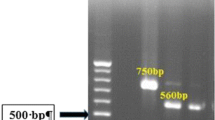Abstract
Cutaneous leishmaniasis (CL) is a major public health problem in Morocco. Three distinct parasites are involved; Leishmania tropica, Leishmania major and Leishmania infantum. The objective of this study is to investigate the epidemiological and the clinical features of endemic foci of CL in Sidi Kacem and Ouazzane provinces in the north of Morocco including molecular identification of parasites. We studied the evolution and the distribution of 1,656 CL cases coming from 39 sectors in these provinces between 1997 and 2012. The causative agents of CL in these areas were identified by using the ITS1-PCR-RFLP method. A tendency of seasonality in incidence was observed, showing a peak in April. Most infected patients were from Ouazzane province. The patients’ ages ranged from 6 months to 85 years; 54% of them were females. The highest rate lesions were found in the age group of 9 years or less and most lesions were localized in the face (79.6%). The movement of populations from neighboring endemic areas and establishment of habitation in areas where housing conditions are unfavorable favored the emergence of the disease.
Résumé
La leishmaniose cutanée (LC) est un problème majeur de santé publique au Maroc. Trois parasites distincts sont impliqués: Leishmania tropica, Leishmania major et Leishmania infantum. L’objectif de cette étude est d’étudier l’épidémiologie et les caractéristiques cliniques des foyers endémiques de LC dans les provinces Sidi Kacem et Ouazzane au nord duMaroc, y compris l’identification moléculaire des parasites.Nous avons étudié l’évolution et la répartition de 1656 cas de LC provenant de 39 secteurs dans ces provinces entre 1997 et 2012. Les parasites responsables de la LC dans ces régions ont été identifiés en utilisant la méthode ITS1- PCR-RFLP. Une tendance à la saisonnalité de l’incidence a été observée, montrant un pic en avril. La plupart des patients infectés étaient de la province d’Ouazzane. L’âge des patients variait de 6 mois à 85 ans; 54 % d’entre eux étaient des femmes. Les taux les plus élevés des lésions ont été trouvés dans le groupe d’âge de 0 à 9 ans et la plupart des lésions étaient localisées sur le visage (79,6 %). Le mouvement des populations des régions endémiques voisines et l’installation des habitations dans les zones où les conditions de logement sont défavorables ont favorisé l’émergence de la maladie.
Similar content being viewed by others
References
Al-Jawabreh A1, Schnur LF, Nasereddin A, et al (2004) The recent emergence of Leishmania tropica in Jericho (A’riha) and its environs, a classical focus of L. major. Trop Med Int Health 9 (7):812–6
Aoun K, Bouratbine A (2014) Cutaneous Leishmaniasis in North Africa: A review. Parasite, 21:14
Aoun K, Ben Abda I, Bousslimi N, et al (2012) Caractérisation comparative des trois formes de leishmaniose cutanée endémiques en Tunisie. Ann Dermatol Vénéréol 139(6-7):452–8
Arroub H, Alaoui A, Lemrani M, Abbari K (2012) Cutaneous Leishmaniasis in Foum Jamâa (Azilal, Morocco): Microenvironmental and Socio-Economical Risk Factors. J Agric Soc Sci 1:10–16
Chaara D, Haouas N, Dedet JP, et al (2014) Leishmaniases in Maghreb: An endemic neglected disease. Acta Trop 132:80–93
Hamdi S, Faouzi A, Ejghal R, et al (2012) Socio-economic and environmental factors associated with Montenegro skin test positivity in an endemic area of visceral leishmaniasis in northern Morocco. Microbiol Res (Pavia) 3:e7
Haouas N, Garrab S, Gorcii M, et al (2011) Development of a polymerase chain reaction-restriction fragment length polymorphism assay for Leishmania major/Leishmania killicki/Leishmania infantum discrimination from clinical samples, application in a Tunisian focus. Diagn Microbiol Infect Dis 68(2):152–8
Kimutai A, Kamau NP, Kiprotich TW, et al (2009) Leishmaniasis in northern and western Africa: A Review. Afr J Infect Dis 3(1):26–30
Lemrani M, Nejjar N, Benslimane A (1999) A new focus of cutaneous leishmaniasis due to Leishmania infantum in Northern Morocco. G Ital Med Trop 4:3–4
Author information
Authors and Affiliations
Corresponding author
About this article
Cite this article
El Miri, H., Faraj, C., Himmi, O. et al. Cutaneous leishmaniasis in Ouazzane and Sidi Kacem provinces, Morocco (1997-2012). Bull. Soc. Pathol. Exot. 109, 376–380 (2016). https://doi.org/10.1007/s13149-016-0522-1
Received:
Accepted:
Published:
Issue Date:
DOI: https://doi.org/10.1007/s13149-016-0522-1
Keywords
- Cutaneous leishmaniasis
- Leishmania tropica
- Leishmania infantum
- molecular identification
- Sidi Kacem
- Ouazzane
- Morocco
- Maghreb
- Northern Africa




